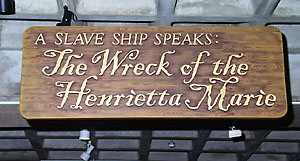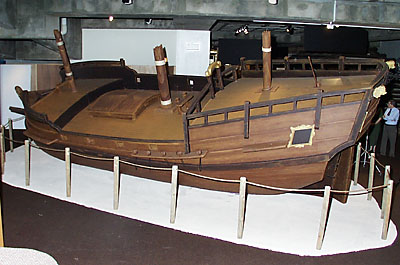

 |
The Henrietta Marie was not a special ship when it was built. It did not go on any world-famous voyages or discover any new lands. It was a common merchant ship just like lots of other merchant ships from the 1600s but it is special to us now because it is the only ship of its kind, a slave trading vessel, that historians have been able to find and identify in American waters. It is also special because the Henrietta Marie is our only link to slave trading ships, the people who sailed them, the cargo they carried, and the horrible conditions Africans were forced to endure in slave ships while crossing the Atlantic Ocean. |
|
Compared to the cargo and transport ships which sail the oceans today, the Henrietta Marie was a relatively small ship. It was constructed of wood and held together with iron spikes. The ship was 60 feet long, weighed 120 tons and had a center mast 50 feet tall. In comparison, the Titanic was almost 900 feet long, weighed 45,000 tons and was 11 stories tall. The Henrietta Marie made two voyages as a slave ship. Probably in November 1697, the ship left on its first voyage to Africa and the Americas. With its many cargo decks, the ship was able to carry many different kinds of freight for trade, including iron, beads, pewter, weapons and slaves. The Henrietta Marie could carry about 200 Africans in the cargo area. |
|
 |
After the Henrietta Marie returned to England in late 1698, the owners began to get her ready to set sail again. They had to round up a new crew, get investors and refit the ship again. It was not until September 1699 that the ship was ready to sail again, this time with John Taylor as captain. The Henrietta Marie arrived in Africa sometime in December 1699 and Jamaica in May 1700. Soon after that, while returning to England on the last leg of the journey, the Henrietta Marie sank off the coast of Florida, where it lay quietly for almost 300 years before being discovered. |
 |
|
|
The real Henrietta Marie still lies on the floor of the Atlantic Ocean, but especially for this exhibit, the staff of the West Virginia State Museum built this half-size replica of the ship. You can see how the ship and some of the exhibit was built here. Continue with the online tour. You can also download a Teacher's Manual for this exhibit. The file is in Adobe Acrobat format; if you need the free Acrobat Reader software, you can get it here. |
|